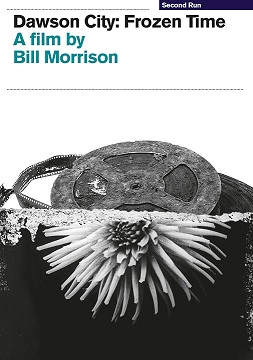'DAWSON CITY: FROZEN TIME' (2016)

- A review by Richard Harrison (2019)
I’ve always been fascinated by discoveries. Whether they are lost
catacombs or lost manuscripts, the idea of something going missing
and then being found- often in dramatic or unexpected fashion-
appeals to me. I’m also a great lover of both silent and
experimental cinema, so the work of Bill Morrison- for me one of the
most important filmmakers working today- resonates all the more
strongly. I first became aware of Morrison through his beautiful and
inspiring film Decasia (2002), where, like all true
artists, he helps us see the world differently and also provides
visually inspiring compositions. Thus, I approached Dawson
City: Frozen Time, his latest film, with higher than average
expectations.
Dawson City: Frozen Time celebrates a remarkable horde of
nitrate celluloid film found beneath the ice in Dawson City- a
remote Yukon town- and from the outset is typically clever and
thoughtful. Rather than simply unfurl the narrative of these films
being discovered with a semi-indecent haste, Morrison outlines (with
the painstaking help of many fragments located in this remarkable
discovery) the history of Dawson City itself, and then how the films
came to be there. By putting things firmly into both social and
historical context, the documentary has much more force, power and
meaning, for it is as much a documentary about history than it is
about film per se.
The archive footage, which encompasses other silent films - such as
Chaplin’s The Gold Rush (1925) and The Trail of ‘98
(1928)- plus newsreels and material found in Dawson City (both
photographs and moving images), is used to support the epic story
being told. This ‘thematicisation’ of the film fragments is
innovative and intelligent, providing an opportunity to use more
clips than perhaps a standard documentary would. The Dawson City
Film Find clips are especially tantalising, offering “a window into
a time that’s gone” as Bill Morrison puts it in a modest,
fascinating interview that is one of the extras. Each clip- even if
on screen for a second or two- is identified, and the appetite
whetted. But, these are mere fragments- invariably of films
that, sadly, no longer exist. That makes their inclusion all the
more poetic, as they are precious examples of what the people of
Dawson City saw over a century ago. Their inclusion throughout the
film gives Dawson City: Frozen Time a greater immediacy and
poignancy.
Rather than use voiceover narration throughout (either through
direct address or via interviews, though the film is book-ended with
some), Morrison opts for a brief yet meticulously-researched text.
The unhurried, leisurely approach is all the more fitting
considering the subject matter- the town which was literally ‘the
end of the line’ for films in the early 1910s. At the centre of much
of the film’s narrative is the Dawson Amateur Athletic Association
(DAAA) building, its frequent appearances making it feel like
(paradoxically) someone you have just met, yet someone you feel that
you have known for years. In fact, the whole film feels like that-
its focus on Dawson City makes you care about the town, its triumphs
and its tragedies. That the latter are featured more prominently is
another reason to feel sad.
The music by Alex Somers is an aural tapestry that evokes with
astonishing richness the sentiments throughout the film, its lyrical
quality being such that I would value a separate soundtrack CD. It
is this as well as the comprehensive and powerful collection of
images that makes Dawson City: Frozen Time an outstanding
and absorbing documentary. Having a story to tell is one thing, but
finding such an engaging way of telling it is quite another. By
locating images that can be synthesised together to support such a
remarkable narrative, Bill Morrison achieves a phenomenal piece of
art- something that transcends the world of cinema to chronicle
human lives in a remote part of the Yukon.
Ultimately, though many of the Dawson City Film Find discoveries
were only fragments of longer films, their images (invariably with
water damaged edges) have a magic that is a result of their rarity.
It is because we are seeing much of the surviving footage
from certain films that they seem more precious. Like Morrison’s
Decasia, the damaged nitrate becomes compelling- especially so
when woven together within the fabric of Morrison’s narrative. This
innovative way of bringing to light (and to life) the discovered
films under the Dawson City ice showcases the diverse nature of the
recovered material, yet also captures the spirit of the era. We care
about Dawson City because Morrison’s film is essentially a very
human film about a community and its resilience. Thus, in watching
Dawson City: Frozen Time and its narrative of the films
located under the ice, we might also discover something about
ourselves along the way.
'Dawson City: Frozen Time' is available from Second Run on
both Blu-Ray and DVD.
Second Run DVD website
Back
Home

